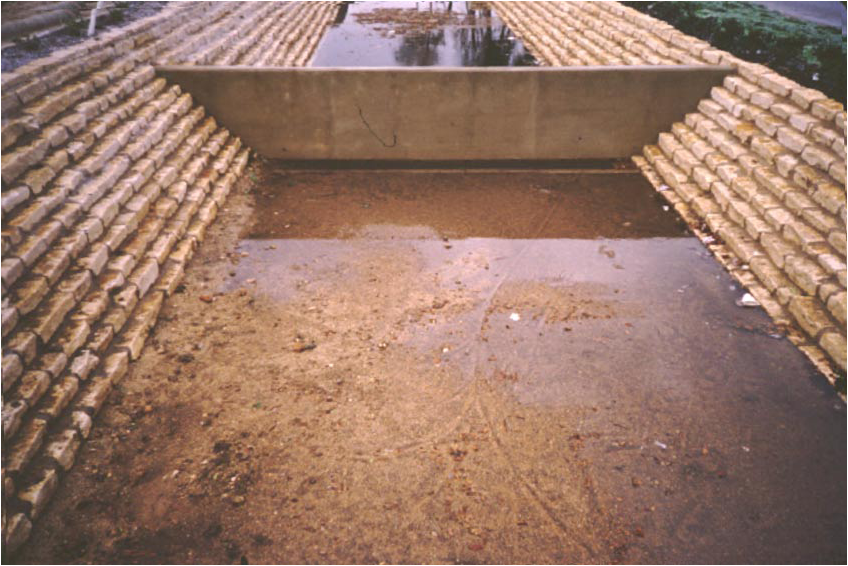1. Rain Gardens | 2. Sand Filters | 3. Infiltration Trenches
Sand Filters Basins
 |
| Picture of Surface Sand Filter |
What is a Sand Filter?
A sand filter, or "filtration basin", is a stormwater quality treatment system that works by using a two-component clarification system: the first is a sediment forebay for settling large particles and the second is a horizontal layer of coarse grained soil that acts as a screen.
Why use Sand Filters?
Sand filters are great for treating the quality of stormwater runoff from large impervious surfaces such as parking lots. They can treat the water from a drainage area of about 10 acres, making them practical for installation on commercial facilities. Sand filters can either collect the stormwater from a large drainage area for treatment at one centrally located filter, or surround the perimeter of an impervious area. These "surface sand filters" are usually constructed at grade. However, if there are serious land constraints, underground filters can be constructed.
How do they manage stormwater?
The main purpose of a sand filter is to collect stormwater, rid it of pollutants, and then discharge the water into the storm sewer system. First, water is routed from an impervious surface to the first treatment cell, the sedimentation chamber. This chamber is either a large tank or just a leak proof depression in the ground where water can be contained. Here, water velocity is reduced, and it is retained long enough to allow suspended sediments to sink to the bottom of the chamber
Next, the water moves to the filter. The filter is simply a few layers of coarse sediment (usually sand and gravel) constructed at grade, and surround with earthen banks. At first, the water pools on top of the filter material, held in place by the banks. Gradually, gravity pulls the water beneath the surface, and infiltrates through the filter. Because the gaps between sand particles are very small, larger sediments are screened out and prevented from permeating any deeper. BOD and coliform bacteria concentrations are also reduced. After the water has propagated through the filter material, it is usually collected in a perforated PVC pipe underdrain, and then transported to the storm sewer system.
Are there any other benefits to having Sand Filters?
Although the primary benefit of this system is the removal of sediment, BOD and coliform from the water before it enters the sewer system, sand filters also reduce peak runoff rates. Water is collected in the sedimentation tank and in the filter media itself during times of high flow rates. It is then retained briefly, and released into the underdrain at a lower flow rate than when it entered the system.
Are there any constraints / design considerations?
One of the issues with a sand filter is that the filter media, i.e. the subsurface sand layers, often needs replacing. After a few years, sediment and hydrocarbons from the drainage area build up in the pores between sand particles. This results in clogging, and the need to replace the sand.
A few changes can be made to the sand filter system outlined above. The first, is that the water can be allowed to exfiltrate out of the sand filter into the surrounding soil instead of using an underdrain. The result of this change in design is that the surface water goes back into the ground, instead of moving to the sewer system for treatment. This design option is only practical if the average water table level is several feet below the bottom of the filter, and the surrounding soil is permeable enough to allow the water to leave the area quickly.
A peat layer can also be included with the filter media. The purpose of the peat layer is to provide microbial communities with a place to grow. These communities treat the passing stormwater more than just the sand alone because they digest and remove dissolved metals and nutrients.
A final design consideration is an emergency spillway or diversion structure. The total retention volume of these filters should be designed to treat the surface runoff of a particular design storm event. In the case that a storm event occurs that is larger than this design storm, an emergency spillway would allow for any excess water pooling on top of the sand filter to flow away. Similarly, a diversion structure could prevent the rain water from an exceptional storm event from even making it to the sedimentation tank.





